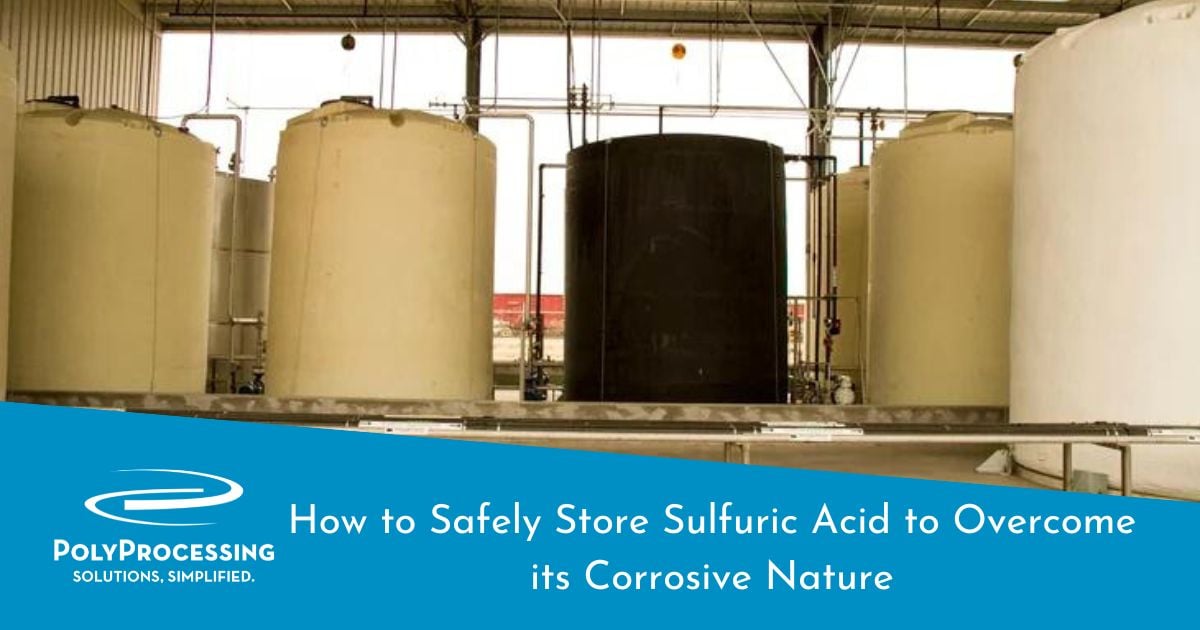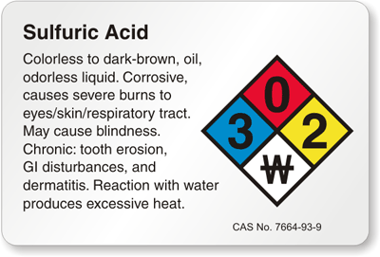How to Safely Store Sulfuric Acid to Overcome its Corrosive Nature
Sulfuric acid (H2SO4) is an NSF/ANSI 61 approved chemical at a 98% concentration or less for Poly Processing’s tank systems.
Sulfuric acid is a highly corrosive mineral acid that challenges traditional storage options. This pungent, colorless to slightly yellow viscous liquid is occasionally dyed dark brown during production to alert people to its hazards. The biggest challenge in working with sulfuric acid is that it is an aggressive oxidizer. This challenges the strength and design of many storage tanks. Poly Processing’s tanks and fittings can be combined specifically to store sulfuric acid and reduce the risks.

Let’s take a closer look at what sulfuric acid is, how it’s used, and how you can overcome its corrosive challenge with the right storage tanks.
What is Sulfuric Acid?
 Sulfuric acid is one of the most widely used chemicals in the U.S., with millions of tons produced each year. It’s used in a wide range of applications, including water and wastewater treatment, car batteries, dyes and pigments, mineral processing, fertilizer manufacturing, oil refining, and the manufacture of chemicals.
Sulfuric acid is one of the most widely used chemicals in the U.S., with millions of tons produced each year. It’s used in a wide range of applications, including water and wastewater treatment, car batteries, dyes and pigments, mineral processing, fertilizer manufacturing, oil refining, and the manufacture of chemicals.
At high concentrations, sulfuric acid can cause serious damage upon contact. It not only causes chemical burns by way of hydrolysis, but also secondary thermal burns through dehydration. It can cause permanent blindness if it makes contact with the eyes and irreversible damage if swallowed. If sulfuric acid is spilled on metals, it can create highly flammable hydrogen gas.
The leading storage challenge of sulfuric acid is its corrosive nature. Its corrosiveness impacts a wide range of materials, like metals, living material, stone, and plastic. This is primarily the result of its strong acidic nature. Furthermore, when concentrated it exhibits strong dehydrating and oxidizing properties.
How to Choose the Best Storage Tank for Sulfuric Acid
The highly corrosive nature of sulfuric acid tests the limits of today’s storage systems. There are three considerations when choosing an ideal storage tank—the acid’s corrosiveness, molecular weight, and the concentration being used.
- Corrosiveness. Because it is an aggressive oxidizer, safeguards are required to prevent polyethylene tanks from becoming brittle and cracking, which could result in leaks or failure of the storage tank.
- Molecular Weight. With a molecular weight of 98.079 g/mol, sulfuric acid is an extremely heavy chemical that will test the mechanical integrity of any material.
- Concentration. This acid displays different properties depending upon the concentration being used. It’s used in three main concentrations, based on the end-use application, those are 93-98%, 80 to 92%, and 80%.
Storage Tank Recommendations for Sulfuric Acid
Through a combination of innovative features, Poly Processing overcomes the storage challenges of sulfuric acid with an ideal storage system that contains these features:
- Antioxidant System. When storing sulfuric acid, it’s important to verify the hoop stress rating and understand the specific gravity ratings to make sure the resins used in the storage tank provide a margin of safety. Poly Processing’s next generation OR-1000™ system bonds the XLPE with an antioxidant inner surface, minimizing oxidation, reducing the potential for fault and maximizing life span.
- Cross-linked polyethylene tanks. With their robust load tolerance, cross-linked polyethylene tanks can handle the chemical’s heavy weight. Also, the Specific Gravity Rating of 2.2 spg. keeps the tank rigid and gives the end user a built in safety factor.
- High-density cross-linked polyethylene (XLPE). The XLPE molecular bonding and thick tank wall are particularly important in the bottom third of the tank, where high levels of load are concentrated.
If secondary containment is needed, the Poly Processing SAFE-Tank® is a smart choice. Along with containing the chemical from its surrounding environment, this double-walled tank greatly lowers the risk for hazardous contact of sulfuric acid with water and other materials. SAFE-Tank® systems for sulfuric acid are designed with the next generation OR-1000™ system.
If secondary containment is present, the IMFO® tank is recommended because the tank’s structural integrity is maximized while providing a molded in full drain fitting at the lowest point of the tank sidewall. When combining this tank design with the OR-1000™ system, oxidation is reduced dramatically.
These tank systems are built based on the concentration of the acid. For 93-98% concentration, 2.2 SPG XLPE with OR-1000, PVC fittings, Viton gaskets, and 316 SS bolts are used. For 81-92% concentration, 2.2 SPG XLPE with OR-1000, PVC fittings, Viton gaskets, and C-276 bolts are used. For 80% or less concentration, 2.2 SPG XLPE, PVC fittings, Viton gaskets, and C-276 bolts are used.
To learn more about properly storing sulfuric acid, check out our complete sulfuric acid storage guide.
- November 2, 2016
- Topics: Chemicals
About Poly Processing
Posts By Topic
Tech Talk Podcast Episodes
Subscribe By Email
Recent Posts
- Protect Your Facility and Your Bottom Line with a Chemical Leak Detection System
- PPC Installation, Operation, and Maintenance Manual: Ensure Tank Longevity
- How To Use The Chemical Resistance Guide
- Better and Safer Alternatives to Downpipes
- Crosslinked Polyethylene Vs. Fiberglass Reinforced Plastic Tanks
Tank Configurator

Find the recommended tank and system components for your chemical storage challenge.
Configure a Tank Package






